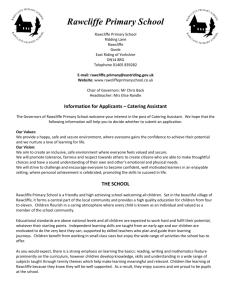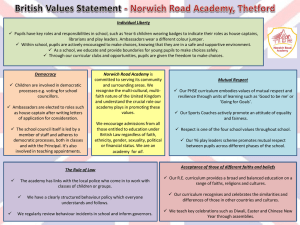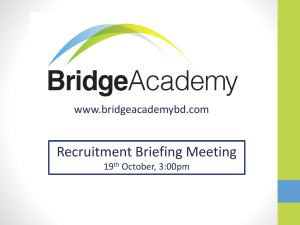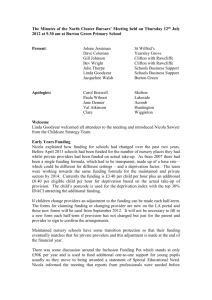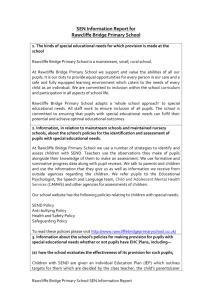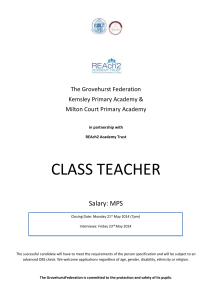Local Offer RB 2016 - Rawcliffe Bridge Primary School
advertisement
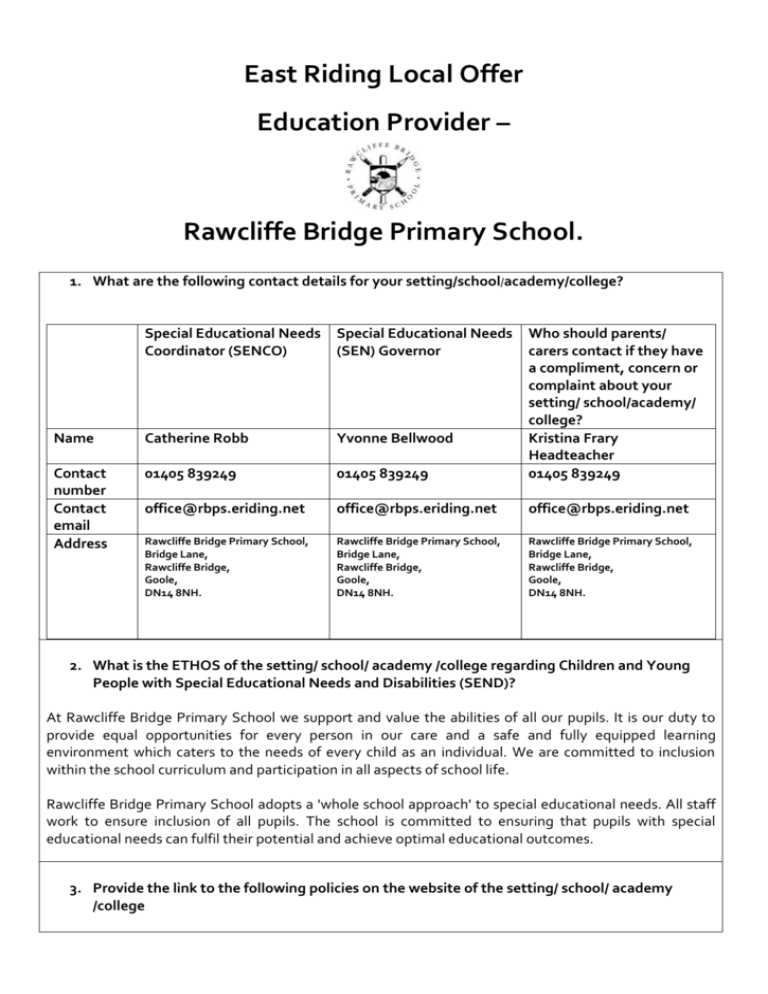
East Riding Local Offer Education Provider – Rawcliffe Bridge Primary School. 1. What are the following contact details for your setting/school/academy/college? Special Educational Needs Coordinator (SENCO) Special Educational Needs (SEN) Governor Name Catherine Robb Yvonne Bellwood Contact number Contact email Address 01405 839249 01405 839249 Who should parents/ carers contact if they have a compliment, concern or complaint about your setting/ school/academy/ college? Kristina Frary Headteacher 01405 839249 office@rbps.eriding.net office@rbps.eriding.net office@rbps.eriding.net Rawcliffe Bridge Primary School, Bridge Lane, Rawcliffe Bridge, Goole, DN14 8NH. Rawcliffe Bridge Primary School, Bridge Lane, Rawcliffe Bridge, Goole, DN14 8NH. Rawcliffe Bridge Primary School, Bridge Lane, Rawcliffe Bridge, Goole, DN14 8NH. 2. What is the ETHOS of the setting/ school/ academy /college regarding Children and Young People with Special Educational Needs and Disabilities (SEND)? At Rawcliffe Bridge Primary School we support and value the abilities of all our pupils. It is our duty to provide equal opportunities for every person in our care and a safe and fully equipped learning environment which caters to the needs of every child as an individual. We are committed to inclusion within the school curriculum and participation in all aspects of school life. Rawcliffe Bridge Primary School adopts a 'whole school approach' to special educational needs. All staff work to ensure inclusion of all pupils. The school is committed to ensuring that pupils with special educational needs can fulfil their potential and achieve optimal educational outcomes. 3. Provide the link to the following policies on the website of the setting/ school/ academy /college SEND Policy Anti-bullying Policy Health and Safety Policy Safeguarding Policy Visit http://www.rawcliffebridgeprimaryschool.co.uk/ then select policy documents and you will find all of the relevant policies. 4. What is the standard admissions number? How many Children and Young People do you have on roll? We currently have 52 pupils on roll at Rawcliffe Bridge Primary School. How many Children and Young People have SEND? 18 pupils have SEND. How many Children and Young People have a statement? Currently no children 5. How does the setting/ school/ academy /college: Identify and assess Children and Young People with SEND? At Rawcliffe Bridge Primary School we use a number of strategies to identify and assess children with SEND. Teachers use the observations they make of pupils alongside their knowledge of child development and progress to make an assessment. We talk to parents as early as possible starting with home visits prior to entry to our nursery. We talk with children and use the information that they give us as well as advice which we receive from outside agencies so that we can plan early and effectively to support varied needs. We may refer pupils to the Educational Psychologist, the Speech and Language team, Child and Adolescent Mental Health Services (CAMHS) and other agencies who can offer professional support and advice for our families and where required provide specific needs assessments for children. In turn we use professional advice to ensure that interventions and support plans are organised well in school. Evaluate the effectiveness of provision for Children and Young People with SEND? Children with SEND are given an Individual Education Plan (IEP) which outlines targets for them which are decided by the class teacher, the child’s parents/carer and the child. These IEPs are reviewed throughout the year to see if the child is making progress and to see where there are other gaps in learning so that effective support can be planned and put in place. Also as part of this process we use impact data to monitor the child’s academic progress. Children with SEND make the same good progress as other children in school (Ofsted 2014) Parent view survey summer 2015- My child is taught well at this school 90% strongly agree. Would you recommend this school to another parent 90% strongly agree Assess and review progress of Children and Young People with SEND? All children are assessed and reviewed formally each half term so that their progress can be monitored, but day to day assessments inform teachers on where the next steps in learning need to be. For children with a EHC plan there are annual reviews held alongside regular pupil reviews. If the class teacher or parents/carers feel that something is not working before a review meeting takes place they are encouraged to contact the school so that the child’s needs can be assessed and reviewed and where necessary targets and support can be re-assessed in order for the child to attain their full potential and make further progress. 6. Who are the best people to talk to in your setting/ school/ academy /college about a Child or Young Persons difficulties with learning/ Special Educational Needs or disability (SEND)? The first person to speak to is the child’s class teacher. You can also speak to the Special Educational Needs Coordinator. Finally you may wish to speak to the head teacher. The school will put you in contact with outside agencies that may be of help to you. 7. What are the different types of support available for Children and Young People with SEND in setting/ school/ academy /college? At Rawcliffe Bridge Primary School we believe in quality first which means we believe that the first point of support is good teaching in the classroom. One to one, buddying and group work are also used to support pupils with SEND. Work is differentiated to meet the needs of all children along with specific literacy, numeracy and nurture programmes to support specific children. Teachers write Independent Education Plans (IEP)for children with SEND in order to outline the support that will be provided to support those pupils. Children and their families work together with the school to work towards IEP aims and children discuss their own views on helpful next steps. There are a range of outside agencies that the school work with in order to provide support to pupils such as the school nursing team, the educational psychologist, the speaking and listening team, social care, healthy lifestyles team, behavioural support team and family support. Key staff are trained in Mental Health First Aid and all staff are trained in Child Protection. 8. How will the setting/ school/ academy /college ensure ALL staff are aware and understand a Child or Young Person’s SEND? As we are such a small school that staff are able to build relationships and get to know all the children throughout the school. The school has profiles for each of their children with SEND which are shared with the relevant people so that they can become familiar with the children. Staff training which is relevant to the needs of pupils within the school is regularly up dated. Pupil reviews facilitate on- going dialogue between staff and with parents/carers and children. 9. How will the setting/ school/ academy /college let a parent/ carer know if they have any concerns about their Child or Young Person’s learning? If the school has concerns about a child’s learning they will first contact the child’s parents/carers to discuss the child and seek their views. This is a two-way process if a parent/carer has any concerns about their child’s learning then they are encouraged to approach the school to discuss them. The school builds up relationships with parents through informal contacts such as talking before and after school. Most SEND children will continue to make progress as a result of careful planning and home/school communication. However where there may sometimes be continued concerns or a clear need for specialist guidance. On these occasions, with the consent of parents and carers, the school may refer children for specialist reviews or assessments in order to identify specific needs such as dyslexia, autism, vision or hearing impairment. This professional assessment will enable the school to follow specific advice and recommendations and any reports from specialists will also be provided for parent/carers in order for home, school and other services to carefully address the needs of the child. 10. How is support allocated to Children and Young People? Support is allocated based on children’s needs and is regularly reviewed to assess its effectiveness. In school support can be given in a number of different ways, it could be a class teacher supporting a group or working one to one with a child, teaching assistants can also support in this way. Intervention strategies can be planned in order to support children with gaps in their learning or with particular areas of difficulty. 11. How does support move between the key stages? As we have mixed year group classes, children will often have the same teacher and teaching support staff for two years or more which reduces periods of settling in with new staff and enable smooth transitions and supports staff knowledge and understanding of children’s progress and needs. When children change teachers we have planned periods of summer term transition which includes teacher swap overs, transition review meetings and IEP discussions. Children in Y6 with SEND are met by Y7 staff from The Snaith School on move up days, teacher visit days and some children attend a summer school at Snaith. All individuals are discussed in a meeting between the Y6 and Y7 teachers during the summer. Children with EHC plans have a transition review during Y5 which involves all agencies, the parent/carers, both schools and the child so that we can plan a smooth entry and settling in period. 12. Which other people and organisations provide services to Children and Young People with SEND in your setting/ school/ academy /college? Rawcliffe Bridge Primary School work with a range of organisations to provide support for children with SEND. Some of the services we work with are; Children’s services Educational psychologist team Speaking and listening team The Integrated physical and sensory service (ISSS) CAMHS (mental health) Children’s centres School Nursing 13. What training have staff received to support Children and Young People with SEND? Staff at Rawcliffe Bridge Primary School have received a range of training so that they understand and can support a range of SEND. Refresher training is carried out when new pupils with SEND enter the school or when staff feel it would be beneficial. Staff at Rawcliffe Bridge have most recently had training in; Dyslexia Youth Mental Health First Aid Numicon Mark Making Self Harm Circle Time Team Teach; which is also known as positive handling training. Safeguarding training ; which teaches staff what to look for in child protection situations and how to handle them. Restorative practice; teaching children to solve their own falling out incidents. The SENCo has the Post Graduate Qualification in SEN Coordination. The Headteacher has been a SENCo for 10 years and holds qualifications in Inclusive Education The Headteacher is a member of the East Riding Strategy Team for Mental Well-Being which links with the parents’ SEND forum (ERVIP) 14. How will teaching be adapted for a Child or Young Person with SEND? We foster a culture in which we support one another and aim to challenge ourselves rather than be better than others. We believe in building solid foundations for all of the children and will adapt our strategies and curriculum to help everyone to find a way to move on to their next step and to gain confidence, knowledge and skills. The school holds the Basic Skills Award for quality of provision in English and Maths and the Science Quality Mark. Teaching is differentiated to meet the needs of all pupils and is inclusive of all children. We talk to the children about what helps them to learn and find that they tell us that talking to their teachers and working with buddies are popular learning strategies. Small classes enable teachers to spend structured feedback and support time with children and we have very successful buddying systems in place across school. We also encourage independent learning and place children’s interests and motivators high on our list of priorities. Lessons include a mixture of activities which meet the needs of; Visual learners (children who learn best by seeing what they are learning about) Auditory learners (children who learn best through listening) Kinaesthetic learners (children who learn best through practical, hands on activities) Children are taught how to use a range of apparatus to support their learning and they encouraged to access the apparatus in lessons if they feel it will help them. Pre-learning is also used to support children with SEND for example teaching assistants can support children to learn vocabulary that they will need to understand in a future lesson. ICT equipment is also used to support children with SEND for example laptops or tablets can be used in writing lessons. 15. What support is available for parents/ carers of a Child or Young Person with SEND? The school has an open door policy where parents and carers of children with SEND can talk to a member of staff whenever they require support. The school can also put them in contact with a range of services who may be able to help them such as Families Information Service Hub (FISH) website School nursing team 01405 752937 Family support 01482 395500 Speech and language team Early years support Educational psychologist 16. How is the setting/ school/ academy /college’s physical environment accessible to Children and Young People with SEND? There are no staircases in the main school as it is on one floor however there is one classroom near the school hall which is a separate building and it is on a lower floor. Rawcliffe Bridge Primary School use a number of visual resources such as drawers labelled with pictures and words and visual timetables to support pupils with SEND. The school has adapted resources and the environment to meet varied needs as required. 17. What facilities are available for Children and Young People with SEND on the setting/ school/ academy /college site e.g. special quiet room, lunchtime club? The school has a library that is used as a quiet area with reading dens for children to use. Inside each classroom there is quiet area for example a castle where children can go and sit quietly when they feel the need. The playground also has a pod and a friendship area where children can go if they feel they need some time alone or if they would like someone to talk to. The school runs a range of clubs that are inclusive such as Box 2B Fit, sewing, guitar, library, IT, writers club, dodgeball, Christmas craft and hockey. Our outdoor curriculum allows children to work outside in our large open spaces. We have gardens and a pond area that children are able to access and use as part of their learning. The field also has a special area inside the willow tunnel where children can spend time. 18. How will Children and Young People be supported during transitions? (when moving to another setting/ school/ college or between classes/ groups in the setting/ school/ college) We are a small nurturing primary school and therefore children get to know and work with all staff which helps with transitions between classes. We send SEND records to transition schools as well as holding transition meetings with them in order to ease transitions and so that the new school can prepare for the child with SEND. The school liaises well with the year seven leaders and teachers. We attend sporting and curriculum events at the local high school so that children can become familiar with it and meet children from other primary schools before their transition. All children spend two full days at their secondary school during the summer term. Between classes at school we have transition meetings between staff and set targets for the autumn term. Children also spend time with their new teacher during the summer term.
